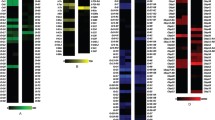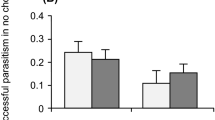Abstract
Many parasitic nematodes have an environmental infective stage that searches for hosts. Olfaction plays an important role in this process, with nematodes navigating their environment using host-emitted and environmental olfactory cues. The interactions between parasitic nematodes and their hosts are also influenced by the olfactory behaviors of the host, since host olfactory preferences drive behaviors that may facilitate or impede parasitic infection. However, how olfaction shapes parasite-host interactions is poorly understood. Here we investigated this question using the insect-parasitic nematode Howardula aoronymphium and its host, the mushroom fly Drosophila falleni. We found that both H. aoronymphium and D. falleni are attracted to mushroom odor and a subset of mushroom-derived odorants, but they have divergent olfactory preferences that are tuned to different mushroom odorants despite their shared mushroom environment. H. aoronymphium and D. falleni respond more narrowly to odorants than Caenorhabditis elegans and Drosophila melanogaster, consistent with their more specialized niches. Infection of D. falleni with H. aoronymphium alters its olfactory preferences, rendering it more narrowly tuned to mushroom odor. Our results establish H. aoronymphium-D. falleni as a model system for studying olfaction in the context of parasite-host interactions.





Similar content being viewed by others
References
Adamo SA (2013) Parasites: evolution's neurobiologists. J Exp Biol 216:3–10
Bargmann CI, Hartwieg E, Horvitz HR (1993) Odorant-selective genes and neurons mediate olfaction in C. elegans. Cell 74:515–527
Brenner S (1974) The genetics of Caenorhabditis elegans. Genetics 77:71–94
Bretscher AJ, Busch KE, de Bono M (2008) A carbon dioxide avoidance behavior is integrated with responses to ambient oxygen and food in Caenorhabditis elegans. Proc Natl Acad Sci U S A 105:8044–8049
Bretscher AJ, Kodama-Namba E, Busch KE, Murphy RJ, Soltesz Z, Laurent P et al (2011) Temperature, oxygen, and salt-sensing neurons in C. elegans are carbon dioxide sensors that control avoidance behavior. Neuron 69:1099–1113
Burger H, Ayasse M, Dotterl S, Kreissl S, Galizia CG (2013) Perception of floral volatiles involved in host-plant finding behaviour: comparison of a bee specialist and generalist. J Comp Physiol A 199:751–761
Carrillo MA, Guillermin ML, Rengarajan S, Okubo R, Hallem EA (2013) O2-sensing neurons control CO2 response in C. elegans. J Neurosci 33:9675–9683
Castelletto ML, Gang SS, Okubo RP, Tselikova AA, Nolan TJ, Platzer EG et al (2014) Diverse host-seeking behaviors of skin-penetrating nematodes. PLoS Pathog 10:e1004305
Cator LJ, George J, Blanford S, Murdock CC, Baker TC, Read AF et al (2013) 'Manipulation' without the parasite: altered feeding behaviour of mosquitoes is not dependent on infection with malaria parasites. Proc R Soc B 280:20130711
Crowley-Gall A, Date P, Han C, Rhodes N, Andolfatto P, Layne JE et al (2016) Population differences in olfaction accompany host shift in Drosophila mojavensis. Proc R Soc B 283:20161562
Debban CL, Dyer KA (2013) No evidence for behavioural adaptations to nematode parasitism by the fly Drosophila putrida. J Evol Biol 26:1646–1654
Dekker T, Ibba I, Siju KP, Stensmyr MC, Hansson BS (2006) Olfactory shifts parallel superspecialism for toxic fruit in Drosophila melanogaster sibling, D. sechellia. Curr Biol 16:101–109
Dillman AR, Guillermin ML, Lee JH, Kim B, Sternberg PW, Hallem EA (2012) Olfaction shapes host-parasite interactions in parasitic nematodes. Proc Natl Acad Sci U S A 109:E2324–E2333
Felix MA, Duveau F (2012) Population dynamics and habitat sharing of natural populations of Caenorhabditis elegans and C. briggsae. BMC Biol 10:59
Gang SS, Hallem EA (2016) Mechanisms of host seeking by parasitic nematodes. Mol Biochem Parasitol 208:23–32
Gaugler R, Campbell JF, Gupta P (1991) Characterization and basis of enhanced host-finding in a genetically improved strain of Steinernema carpocapsae. J Invertebr Pathol 57:234–241
Gleave K, Cook D, Taylor MJ, Reimer LJ (2016) Filarial infection influences mosquito behaviour and fecundity. Sci Rep 6:36319
Goldman-Huertas B, Mitchell RF, Lapoint RT, Faucher CP, Hildebrand JG, Whiteman NK (2015) Evolution of herbivory in Drosophilidae linked to loss of behaviors, antennal responses, odorant receptors, and ancestral diet. Proc Natl Acad Sci U S A 112:3026–3031
Grimaldi D (1985) Niche separation and competitive coexistance in mycophagous Drosophila (Diptera: Drosophilidae). Proc Entomol Soc Wash 87:498–511
Hallem EA, Sternberg PW (2008) Acute carbon dioxide avoidance in Caenorhabditis elegans. Proc Natl Acad Sci U S A 105:8038–8043
Hallem EA, Dillman AR, Hong AV, Zhang Y, Yano JM, DeMarco SF et al (2011a) A sensory code for host seeking in parasitic nematodes. Curr Biol 21:377–383
Hallem EA, Spencer WC, McWhirter RD, Zeller G, Henz SR, Ratsch G et al (2011b) Receptor-type guanylate cyclase is required for carbon dioxide sensation by Caenorhabditis elegans. Proc Natl Acad Sci U S A 108:254–259
Hamilton PT, Leong JS, Koop BF, Perlman SJ (2014) Transcriptional responses in a Drosophila defensive symbiosis. Mol Ecol 23:1558–1570
Hammer Ø, Harper DAT, Ryan PD (2001) PAST: paleontological statistics software package for education and data analysis. Palaeontol Electron 4:9pp
Haselkorn TS, Cockburn SN, Hamilton PT, Perlman SJ, Jaenike J (2013) Infectious adaptation: potential host range of a defensive endosymbiont in Drosophila. Evolution 67:934–945
Hotez PJ, Alvarado M, Basanez MG, Bolliger I, Bourne R, Boussinesq M et al (2014) The global burden of disease study 2010: interpretation and implications for the neglected tropical diseases. PLoS Negl Trop Dis 8:e2865
Jaenike J (1985) Parasite pressure and the evolution of amanitin tolerance in Drosophila. Evolution 39:1295–1301
Jaenike J, Anderson TJC (1992) Dynamics of host-parasite interactions: the Drosophila-Howardula system. Oikos 64:533–540
Jaenike J, Perlman SJ (2002) Ecology and evolution of host-parasite associations: mycophagous Drosophila and their parasitic nematodes. Am Nat 160(Suppl 4):S23–S39
Jaenike J, Grimaldi DA, Sluder AE, Greenleaf AL (1983) α-amanitin tolerance in mycophagous Drosophila. Science 221:165–167
Jaenike J, Unckless R, Cockburn SN, Boelio LM, Perlman SJ (2010) Adaptation via symbiosis: recent spread of a Drosophila defensive symbiont. Science 329:212–215
Jasmer DP, Goverse A, Smant G (2003) Parasitic nematode interactions with mammals and plants. Annu Rev Phytopathol 41:245–270
King JY, Ferrara R, Tabibiazar R, Spin JM, Chen MM, Kuchinsky A et al (2005) Pathway analysis of coronary atherosclerosis. Physiol Genomics 23:103–118
Kodama-Namba E, Fenk LA, Bretscher AJ, Gross E, Busch KE, de Bono M (2013) Cross-modulation of homeostatic responses to temperature, oxygen and carbon dioxide in C. elegans. PLoS Genet 9:e1004011
Koppenhofer AM, Fuzy EM (2008) Attraction of four entomopathogenic nematodes to four white grub species. J Invertebr Pathol 99:227–234
Kreher SA, Mathew D, Kim J, Carlson JR (2008) Translation of sensory input into behavioral output via an olfactory system. Neuron 59:110–124
Lee J, Dillman AR, Hallem EA (2016) Temperature-dependent changes in the host-seeking behaviors of parasitic nematodes. BMC Biol 14:36
Linz J, Baschwitz A, Strutz A, Dweck HK, Sachse S, Hansson BS et al (2013) Host plant-driven sensory specialization in Drosophila erecta. Proc R Soc B 280:20130626
Markow TA (2015) The secret lives of Drosophila flies. eLife 4:e06793
Markow TA, O'Grady P (2008) Reproductive ecology of Drosophila. Funct Ecol 22:747–759
Milan NF, Kacsoh BZ, Schlenke TA (2012) Alcohol consumption as self-medication against blood-borne parasites in the fruit fly. Curr Biol 22:488–493
Nichols CD, Becnel J, Pandey UB (2012) Methods to assay Drosophila behavior. J Vis Exp 61:3795
Pellegrino M, Nakagawa T, Vosshall LB (2010) Single sensillum recordings in the insects Drosophila melanogaster and Anopheles gambiae. J Vis Exp:1–5
Perlman SJ, Jaenike J (2003) Infection success in novel hosts: an experimental and phylogenetic study of Drosophila-parasitic nematodes. Evolution 57:544–557
Pullan RL, Smith JL, Jasrasaria R, Brooker SJ (2014) Global numbers of infection and disease burden of soil transmitted helminth infections in 2010. Parasit Vectors 7:37
Rengarajan S, Hallem EA (2016) Olfactory circuits and behaviors of nematodes. Curr Opin Neurobiol 41:136–148
Robinson AF (1995) Optimal release rates for attracting Meloidogyne incognita, Rotylenchulus reniformis, and other nematodes to carbon dioxide in sand. J Nematol 27:42–50
Sokolowski MB (1985) Genetics and ecology of Drosophila melanogaster larval foraging and pupation behavior. J Insect Physiol 31:857–864
Syed Z, Leal WS (2009) Acute olfactory response of Culex mosquitoes to a human- and bird-derived attractant. Proc Natl Acad Sci U S A 106:18803–18808
Thomas F, Brodeur J, Maure F, Franceschi N, Blanchet S, Rigaud T (2011) Intraspecific variability in host manipulation by parasites. Infect Genet Evol 11:262–269
Acknowledgements
We thank the Caenorhabditis Genetics Center and Bloomington Drosophila Stock Center for strains, Sophie Rengarajan and Wendy Fung for assistance with motility assays, and Michelle Castelletto for insightful comments on the manuscript. J.A.C. was a UCLA Amgen Scholar (2016), UCLA Maximizing Student Diversity Scholar (2016), UCLA Center for Academic & Research Excellence (CARE) Scholar (2016), and a Whitcome Undergraduate Research Fellow (2015). He was supported by NIGMS grant R25GM055052 to T. Hasson. E.A.H. is a MacArthur Fellow and Howard Hughes Medical Institute Faculty Scholar.
Author information
Authors and Affiliations
Corresponding author
Electronic supplementary material
ESM 1
(PDF 354 kb)
Rights and permissions
About this article
Cite this article
Cevallos, J.A., Okubo, R.P., Perlman, S.J. et al. Olfactory Preferences of the Parasitic Nematode Howardula aoronymphium and its Insect Host Drosophila falleni . J Chem Ecol 43, 362–373 (2017). https://doi.org/10.1007/s10886-017-0834-z
Received:
Revised:
Accepted:
Published:
Issue Date:
DOI: https://doi.org/10.1007/s10886-017-0834-z




